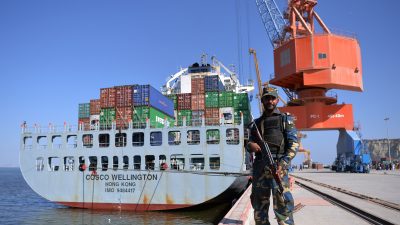Commander of US Central Command (CENTCOM) “Concerned” about China’s “Belt and Road” (BRI)
Is Taking S-CPEC+ Real Seriously

The Commander of US Central Command (CENTCOM) told the House Armed Services Committee just how “concerned” he is about China projecting its Silk Road influence from Gwadar to Africa through S-CPEC+ and consequently establishing a permanent naval presence in the western end of the Afro-Asian Ocean.
CPEC is increasingly being appreciated as the game-changing geostrategic megaproject that it is after the Commander of US Central Command (CENTCOM) told the House Armed Services Committee just how “concerned” he is about its terminal port of Gwadar being used as China’s launching pad for expanding its Silk Road influence into Africa and consequently establishing a permanent naval presence along the routes connecting several Sea Lines Of Communication (SLOC) between them. This outlook isn’t a unique one and was most recently elaborated upon by the author last week in his piece about how “Pakistan’s Indian Sub Interception Proves The Importance Of The Country’s Navy”, but it appears to be the first time that a high-level American military official publicly confirmed the likelihood of this scenario unfolding and expressed “concern” about it. According to reports, Joseph Votel told the Committee that:
“As they develop that land route what they are attempting to do and then we expect then be looking for ports they can connect that to ports in southern Pakistan leading to ports in AFRICOM (US Africa Command), and for us it’s going to lead to a permanent presence of Chinese maritime military maritime activity in the region that we will need to be concerned with.” (author’s note: reproduced exactly as reported by The Times Of India, grammatical errors and all)
This brief statement is loaded with a lot of strategic significance. Firstly, it implies that the joint Indian-American Hybrid War on CPEC has failed and that the Chinese-built megaproject is proceeding apace in turning Pakistan into the global pivot state for facilitating transcontinental multipolar integration.
Secondly, it draws attention to the southern branch of CPEC’s logical expansion that the author earlier coined S-CPEC+. Thirdly, Votel is convinced that this will also take on military dimensions as China is compelled to defend its SLOCs all along this route, possibly through the clinching of LEMOA-like deals with Pakistan and coastal African countries. And finally, the fourth main point that can be drawn from the CENTCOM Commander’ s statement is that China’s CPEC-assisted expansion of influence into the western Afro-Asian Ocean poses a multidimensional cross-theater challenge to American hegemony in the Eastern Hemisphere.
What’s less clear, however, is how the US intends to counter this after the failure of the Indian-American Hybrid War on CPEC. Resorting to similar measures against the Horn of Africa and East African states might backfire for several reasons, not least of which is that the interests of the US’ partners overlap with China’s own in this space and would therefore be adversely affected by regional destabilization. It’s possible that the US might weaponize comparatively low-level chaos dynamics such as those embodied by al Shabaab but this could inadvertently create opportunities for Russia to export its “Democratic Security” model from the Central African Republic to the African coastland and actually safeguard the long-term strategic viability of S-CPEC+, hence why non-kinetic methods will probably be relied upon at this point in time.
It’s very likely that the US will intensify its infowar against China’s Belt & Road Initiative (BRI), with specific focus being given to the narrative that Beijing is more interested in extracting resources through so-called “debt trap diplomacy” than in sincerely developing its partners’ economies. There might also be more underhanded efforts to incite mob violence against Chinese citizens in order to bait the People’s Republic into costly “mission creep” that it’s both militarily unprepared for and which could exacerbate some of the angry locals’ negative perceptions about it. In addition, the US could use economic pressure to dissuade African governments from signing LEMOA-like deals with China and entice them into embracing “Trumpism” instead of Silk Road-led Globalism. Fearmongering about China’s speculative military motives, the US might use this as the pretext for launching Indian-led multilateral “freedom of navigation” patrols.
The most likely outcome that the US hopes to achieve is to encourage “friendly competition” between BRI and the nascent Indo-Japanese “Asia-Africa Growth Corridor” while manipulatively working behind the scenes to influence the “rules of the game” in such a way as to favor its proxies and their French and Emirati partners prior to using their multilateral economic platform as the basis for the creation of a new African-centric security bloc for more comprehensively “containing” China. Accordingly, it would be to the benefit of the emerging Multipolar World Order if China partnered with Pakistan, Turkey, and Russia to preemptively thwart this scenario, with the first protecting S-CPEC+’s SLOCS, the second sharing its widespread soft power in sub-Saharan Africa, and the last using its “Democratic Security” model to safeguard everything in the most ideal win-win arrangement between them all.
*
Note to readers: please click the share buttons below. Forward this article to your email lists. Crosspost on your blog site, internet forums. etc.
This article was originally published on Eurasia Future.
Andrew Korybko is an American Moscow-based political analyst specializing in the relationship between the US strategy in Afro-Eurasia, China’s One Belt One Road global vision of New Silk Road connectivity, and Hybrid Warfare. He is a frequent contributor to Global Research.

